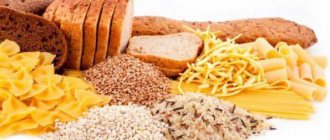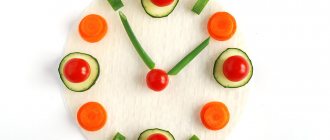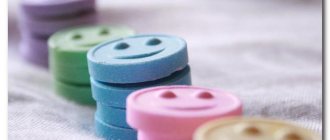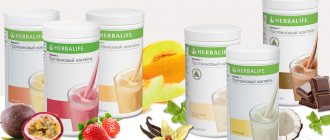Cheat meals are one of the most common methods of psychological relief for those losing weight. It involves eating some foods that are prohibited on the diet and reduces the risk of eating disorders and overeating.
Using a cheat meal when losing weight should be planned: it can occur on a weekend, a difficult weekday, or a holiday feast.
What is a cheat meal?
The name of the method, cheat meal, comes from “cheat meal.” A cheat meal is a diet disorder that is planned in advance and allows you to eat your favorite junk food for a short period of time.
Effective weight loss is based on a calorie deficit in the diet and consumption of permitted foods (healthy fats, lean proteins and complex carbohydrates). Long-term restrictions cause stress and provoke breakdowns from the diet, especially with long-term adherence to proper nutrition. A planned day for eating junk food reduces psychological stress and improves the condition of the person losing weight.
In the Three Fists Diet, cheat day is on Friday.
Some long-term diets involve the presence of a cheat meal: for example, the “Three Fists” diet includes a “Zigzag-plus” day, which includes 1 serving of a harmful product of the choice of the person losing weight.
The goals of the “free period” are not limited to emotional stability and reduction of eating stress. Short-term relief in the diet is intended to accomplish the following tasks:
- Increased thermogenesis. Eating junk food high in fat and carbohydrates activates the digestive and endocrine systems. The nutritional “swing” between calorie intake during a diet and a cheat meal increases metabolic activity. Body temperature the day after the day of indulgence may be slightly increased, which allows for increased calorie expenditure. You can achieve a similar effect during a diet using drinks with spices (red pepper, ginger, etc.).
- Cleansing the gastrointestinal tract from protein food residues. Protein-rich foods provide long-term satiety, so many people who are losing weight actively consume lean meat, cottage cheese, eggs, fish, etc. Long-term satiety is due to the difficulty of digesting proteins. If there is a lack of enzymes or the consumption of proteins in the evening, such food is not fully absorbed, which complicates the function of the gastrointestinal tract. A short break allows your digestion to take a break from a low-fat, high-protein menu.
An analogue of a cheat meal is a refeed, which uses biochemical reactions of carbohydrate metabolism to accelerate weight loss.
Cheat meal and refeed - how to eat tasty treats and lose weight
Cheat meal and refeed are called a planned short-term diet violation. According to scientists and nutritionists, the more comfortable the diet, the easier it is to stick to it. A balanced diet that includes a wide range of food groups - whole grains, meat, poultry, eggs, fish, vegetables, fruits and dairy products - as well as a small proportion of treats in the diet makes a comfortable diet. Cheat meals and refeeds will help you make forbidden foods part of your weight loss strategy.
Cheat meal: advantages, disadvantages and recommendations
A cheat meal is a planned meal for which you choose what you have been craving for a long time. If you've been limiting carbohydrates, then choose high-carb foods, and if you've been limiting fats, then you can indulge in a high-fat dish. Of course, if you've been eating healthy and in a calorie deficit, just allow yourself to eat your favorite forbidden food.
Advantages:
- Psychological relief - by eating a “forbidden” product without anxiety, you internally calm down and understand that the food will not disappear, you do not forbid yourself anything, but only follow certain rules.
- Reduce Stress – If you've been strictly controlling your diet and exercising for a few weeks, you've built up enough stress and with it the hormone cortisol. Cortisol causes fluid retention, so you may feel like your weight is stagnant. Cheat meals help reduce stress and cortisol levels, as well as combat fluid retention.
Flaws:
- The risk of losing control over oneself, which will block all efforts;
- Discomfort and bloating after eating foods uncharacteristic of the diet.
Recommendations for a cheat meal
If you are afraid that you will lose control of yourself and eat twice as much, then have a cheat meal outside the home - in a cafe or restaurant. There you certainly won't order several main courses and three desserts on top.
The best time for a cheat meal is dinner. There is a high probability that having “tasted the forbidden fruit” in the morning, it will be difficult to stick to your diet for the rest of the day.
For better appetite control, be sure to include healthy foods at this meal - a lean source of protein and a salad.
Lyle MacDonald, a world-renowned nutritionist, suggests limiting free eating to 60 minutes. This allows you to organize yourself and not turn a cheat meal into hours of eating. Plan your cheat meal in advance. Planning helps you stay in control.
And finally, how often can you do a cheat meal? If you have a lot of excess weight - your body mass index indicates severe overweight or obesity - then you should eat freely no more than once every two weeks. If your weight is within the normal range or your BMI indicates that you are slightly overweight, it is optimal to have a cheat meal once a week.
Refeed: advantages, disadvantages and recommendations
If a cheat meal is one meal, then the duration of the refeed can be up to three days. The refeed is done with carbohydrate foods, and fats are reduced as much as possible. That is, you won't be able to afford a large portion of ice cream, but you will be able to enjoy a large bowl of pasta. It is advisable to carry out carbohydrate loading on low-carbohydrate diets. The amount of carbohydrates for a refeed increases to 3-5 g per kilogram of weight. If you don't know how your body reacts to large amounts of carbohydrates, it's best to start with a minimum.
Advantages:
- Psychological relief and stress reduction;
- Replenishment of glycogen reserves in muscles, which will allow you to train more intensely;
- Stopping catabolic processes and maintaining muscle mass;
- Stabilization of hormonal levels - increase leptin, reduce ghrelin and cortisol.
Flaws:
- Short-term fluid retention after eating large amounts of carbohydrates. Nutritionists recommend not weighing yourself for three days;
- Risk of loss of self-control.
Recommendations for conducting a refeed
To get more benefit from a refeed, you need to deplete your glycogen stores. Do a full body strength training session before carb loading. Perform each exercise in 2-3 sets of 12-15 repetitions.
If you are doing a refeed for the first time, then focus on the amount of carbohydrates at 3 g per kilogram of your weight, but fats should not go beyond 50 g. Keep proteins within 1.5-2 g/kg.
How often you refeed depends on the type of low-carb diet you are on and your weight. People who are overweight are recommended to refeed for one day every 10-14 days. People with normal body weight can carbohydrate load one day every 7-10 days.
Remember that a cheat meal is one small meal. There is no need to test the strength of your stomach, trying to figure out how much food will fit in it. If you choose, for example, Honey Cake for your cheat meal, eat one piece, not the whole cake. Similar to the refeed, if you were on a low carb diet, then you need to increase your carbs rather than eat a ton of protein and fat. And since the refeed is longer, choose healthy sources of carbohydrates that you denied yourself - sweet fruits, potatoes, pasta.
Author: Ekaterina G., nutritionist, fitness blogger (especially for Calorizator.ru) Copying this article in whole or in part is prohibited.
Benefits and harms
Cheat meal has the following beneficial properties:
- allows you to relieve psychological stress caused by strict restrictions and eat a portion of your favorite unhealthy product without feeling guilty;
- “deceives” the body by loading it with more calories than the dietary norm allows;
- reduces the risk of diet failure and allows you not to be fixated on thoughts of junk food while losing weight;
- maintains motivation to lose weight during long-term dieting;
- Due to its effect on thermogenesis, it accelerates the burning of fat reserves.
Despite the benefits, the practice of “free days” in nutrition also has negative aspects:
- excess carbohydrates and salt (in smoked meats, fast food, salted nuts, etc.) leads to fluid retention and the appearance of edema;
- consuming large amounts of carbohydrates can dramatically load the endocrine system (islets of Langerhans), which are responsible for the production of insulin;
- a sharp increase in the proportion of lipids after a low-fat diet harms the pancreas, which produces enzymes to digest all nutrients;
- excessive consumption of junk food during a cheat meal or frequent “free days” can significantly reduce or even completely compensate for excess weight loss during the diet;
- with insufficient motivation and eating disorders, a deviation from the diet may last several days instead of one.
The disadvantage of this method is that it can be a “cover” for an eating disorder. In order to monitor the presence of breakdowns and develop the habit of controlling nutrition, cheat meals should only be carried out as planned.
Cheat meal or not
Cheat meal is a concept in professional bodybuilding; its use is justified not only in big sports, but also in regular fitness.
Video
Who needs it
- Bodybuilders cheat meals on cutting, low-carb diets, and during preparation for competitions.
- Those losing weight are recommended to include Cheat meals in their diet if a plateau effect occurs: weight and volume do not decrease, despite titanic efforts.
- It is justified to deviate from the diet when you have run out of strength for training, motivation decreases, and your general condition worsens - it is better to cheat and continue the fight than to break down and quit the race.
Who is contraindicated for “belly festival”?
At the very beginning of the journey, when a person has just begun to change his eating behavior, not a single serious fitness trainer recommends a cheat meal. Calorie content, diet, physical activity cannot be called prohibitive, weight is steadily decreasing - there are no reasons for relaxation. For people who suffer from food addiction to one degree or another (and these are the majority of those losing weight), a cheat meal is unacceptable. Once they try the forbidden fruit, they will not be able to restrain themselves - the celebration of the belly will end in elementary gluttony, which will negate all previous efforts.
Video
How to deal with diseases
Having problems with the stomach, gall bladder and pancreas, you will have to plan weight loss with your doctor. Only on his recommendation is this or that product introduced into the diet. As a rule, your favorite food becomes unavailable also because it upsets the gastrointestinal tract. Even absolutely healthy people are recommended to have a cheat meal, having enzyme preparations from the pharmacy on hand.
Contraindications
Contraindications to cheat meals are:
- Inflammatory processes in the gastrointestinal tract. A sharp change in diet during gastritis, gastroduodenitis and pancreatitis can provoke an exacerbation of chronic inflammation or cause unpleasant side effects (heartburn, heaviness and pain in the abdomen, nausea, etc.). In case of severe enzymatic deficiency and gastrointestinal ulcers, days free from diet rules are prohibited.
- Obesity. If there is a large amount of excess weight, a long-term balanced diet is prescribed. Strict low-carb diets that require carbohydrate loading are not recommended for long-term adherence and are therefore not suitable for obesity. The possibility of using a cheat meal when losing weight (“plateau”) requires consultation with a nutritionist.
- Long-term strict diet. The digestive system adapts to the diet, producing less of certain enzymes with a reduced intake of proteins, fats or carbohydrates. The intake of a large amount of nutrients overloads the gastrointestinal tract, and a lack of enzymes leads to heaviness in the abdomen, pain in the left hypochondrium, nausea and vomiting, stool disorders and flatulence. It is most dangerous to spend a busy day on unhealthy foods after low-fat, therapeutic and vegetarian diets.
- Eating disorders. With eating disorders (ED), there is no possibility of self-control in the area of nutrition, so those losing weight cannot plan a diet and cheat meal. Breakdowns and overeating after a short-term diet disorder aggravate depression, anxiety disorder and dissatisfaction with oneself. This pathology requires a visit to a psychotherapist and nutritionist. A balanced and proper diet is only part of the therapy: patients with eating disorder are necessarily prescribed medication and psychotherapy.
It is not advisable to use carbohydrate loading for diabetes mellitus. Excessive carbohydrate consumption with insulin deficiency or insulin resistance negatively affects the pancreas and sugar levels.
Fructose, which is used as a substitute for white sugar, may short-term increase levels of the satiety hormone (leptin) by increasing body fat, but does not engage the insulin mechanism, so it is less beneficial for weight loss.
While carrying a child, you should adhere to a stable caloric intake, which is selected in accordance with the age, height, weight and position of the woman. Cheat meals can aggravate pregnancy complications: enzyme deficiency, gestational diabetes, constipation and swelling.
Efficiency
The effectiveness of a cheat meal is determined by psychological comfort during the diet. If dietary restrictions are tolerated without breakdowns or overeating, then the method is effective and can be used until the end of the diet period.
Carbohydrate loading allows you to prevent the “plateau” effect or continue weight loss if weight loss has stopped.
You should not weigh yourself immediately after a loading day: swelling can cause an increase of up to 2-3 kg, which will negatively affect the motivation to lose weight. The results of the diet need to be assessed comprehensively, after every 2-4 weeks.
Basic Rules
When conducting a cheat meal, you must follow several basic rules:
- Plan your loading day in advance. You need to schedule a cheat meal 3-4 days before it takes place. This could be a day of a festive feast, difficult sports training, hard mental or physical work.
- Maintain your usual diet. Eating prohibited foods is not allowed all day, despite the name of the method “cheat day” in some sources. It is recommended to forget about the rules of the diet only during one meal, which is planned for the day (lunch, dinner or afternoon snack).
- Don't rush while eating. The goal of a cheat meal is to get maximum pleasure from junk food, which will allow you to go through several days of dieting without regrets. You cannot eat prohibited foods on the go or blame yourself for what you eat. You should also avoid watching movies or social networks while eating: when distracted, those losing weight often overeat, which can lead to extra pounds and heaviness in the stomach.
- Have a light dinner after the cheat meal. After loading, you can limit yourself to a salad, a glass of juice or kefir, since a large number of calories and fatty foods stop evening hunger. It is prohibited to have a loading meal in the evening, because the metabolic rate at this time decreases, and the calories consumed are easily stored in the fat depot.
- Help the body cope with excess fats and carbohydrates. To reduce the load on the gastrointestinal tract when loading, you can take 1 tablet of enzymatic agents (Creon, Festal, Mezim, Pancreatin, etc.). This will make it easier to digest fatty foods and avoid side effects. To reduce swelling after a cheat meal, it is recommended to increase potassium intake (dried apricots, prunes, apricots, apples, seaweed, almonds, legumes, etc.).
- Avoid stress. A cheat day may seem like the best way to deal with stress, as it allows you to eat it up and get a dose of endorphins. However, severe anxiety dramatically increases the risk of overeating, and excess high-calorie foods can reduce the effectiveness of the diet.
- Exercise. To correct your figure and prevent physical inactivity, you need to train at least 3-4 times a week. Preferred are cardio exercises (aerobics, cycling, dancing) and fitness with light weights (1.5-3 kg).
- Lead a healthy lifestyle. To effectively lose weight, you must follow a sleep and rest schedule (at least 8 hours of sleep per day) and drink 1.5-2 liters of fluid per day. Lack of sleep and water negatively affects the state of the endocrine and excretory systems, respectively.
It is recommended to reduce the amount of carbohydrates during the diet to 50-100 g per day, obtaining them from non-starchy vegetables, fruits, berries, a small amount of cereals and legumes.
Balance is important in everything
With low-calorie diets, the body becomes stressed as it tries to conserve energy by reducing thyroid hormones. As a result of such a diet, hormonal imbalance occurs, metabolism is disrupted, and metabolism slows down. To restore hormonal balance, a weekly cheat meal will help. High-calorie foods will help normalize the level of the hormone leptin, which neutralizes the negative effects on the body.
Most nutritionists do not welcome the huge variety of modern diets. It is much more important to change your diet and follow it throughout your life. If there is a clear understanding that your health depends on this, it will be much easier to take the first step. And don’t forget about physical activity, walks in the fresh air and positive emotions.
The concept of a “cheat meal” can be interpreted by many as the uncontrolled stuffing of food into oneself. Therefore, before such “feats” it is worth thinking about, is it necessary? If you overdo it, the goal will be left far behind, not to mention the morale.
Of course, lovers of sweets can have coffee and cake once a week, but again, if this dessert is not of dubious quality. All sorts of binges, even one-time ones, like a cheat meal, are primarily a burden on the body.
We recommend reading about how to count calories to lose weight. You will learn about the pros and cons of mathematics for weight loss, counting calories in dishes and food products, and creating menus. And here is more information about a strict diet for quick weight loss.
There are so many people, so many opinions, and cheat meals have both supporters and opponents. The main criterion is a clear understanding of whether a person needs it, whether he is able to hold out for a month, two, six months without losing track of his intended goal, because staying on a certain diet for a long time is not so easy. In any case, you can have a cheat meal once, it won’t hurt.
How much can you eat?
The serving size of unhealthy foods during a cheat meal is determined by those losing weight themselves. Nutritionists and fitness trainers do not recommend exceeding the daily caloric intake of the diet by more than 1.5 times.
With average height and a minimum level of physical activity (sedentary work, household chores, low-intensity fitness no more than 2-3 times a week), the calorie intake for weight loss is 1200-1300 kcal. The nutritional value of the loading day menu is 1800 kcal.
Taking into account a light dinner, the calorie content of a serving of junk food should be no more than 700-800 kcal. The serving size depends on the calorie content of 100 g of product.
| Product | Calorie content (kcal per 100 g) |
| Pizza | 250-350 (the most high-calorie pizza is with a lot of bacon and cheese, the least - with lean ham, tomatoes and herbs) |
| Double cheeseburger, 1 pc. | 446 |
| Smoked sausage | 400-450 |
| Cake | 300-500 |
| Milk chocolate | 535 |
| Ice cream sundae | 227 |
| Chips | 520-535 |
| Marshmallows in chocolate, 1 pc. | 120 (400 kcal per 100 g) |
| Chocolate candies | 345-600 |
| Almonds in milk truffle | 566 |
| French fries | 312 |
| Grape | 67 |
| Dates | 274 |
| Bananas, 1 fruit | 150 |
| Breaded chicken wings, 1 serving (3 wings) | 254 |
| Milkshake, 1 serving (300 ml) | 336 |
| Carbonated sweet drinks (Coca-Cola, Fanta, etc.), 1 glass | 95-118 |
Return to diet
Nutrition after a cheat meal remains the same: those losing weight return to the diet and the recommended caloric intake (1200 kcal or more depending on height and weight).
On the day after the loading day it is prohibited:
- dramatically change the diet and composition of the diet;
- overeat and continue cheat meals;
- fast to compensate for excess calories;
- reduce the level of physical activity.
Some diets require a fasting day immediately after a cheat meal (for example, in the “Fifteen” diet this is called “Zigzag minus”), but there is no need for a sharp reduction in calories. To unload the body, you can increase the proportion of sources of potassium and fiber in the diet for 1-2 days.
The day after loading, you can extend your sports training and increase the intensity of strength and endurance exercises.
What is a refeed?
Refeed (from “refeed” - recharge) is a carbohydrate loading of the body during a low-carb diet. Like a cheat meal, it is a planned deviation from the usual diet, but it is carried out only to speed up metabolism, and not for psychological relief.
The mechanism of action of refeed is due to changes in the level of the hormone leptin. This hormone reduces hunger and affects metabolic activity. A decrease in its concentration leads to a slowdown in metabolism.
The synthesis of the satiety hormone occurs in adipocytes (fat cells). During a diet, the volume of fat depot decreases, which leads to a decrease in leptin levels and a slowdown in metabolism. This provokes an increased feeling of hunger and a “plateau” effect (stopping weight loss while getting used to calorie restriction).
Short-term carbohydrate loading allows you to:
- increase leptin levels and metabolic rate;
- maintains normal levels of sex hormones (the synthesis of estrogen and testosterone is stimulated by leptin);
- increases immunity, which decreases due to a strict diet;
- improves concentration and cognitive functions;
- increases strength and endurance during sports training.
Refeeds are not carried out at specified intervals. This deviation from dietary nutrition may be due to the following factors:
- weight loss against the background of a reduced caloric intake (dietary “plateau”);
- a sharp deterioration in sports performance (number of repetitions of strength exercises, weight lifted, endurance during cardio exercise);
- decreased immunity, endocrine disorders, chronic fatigue and loss of concentration.
If there is no deficit of carbohydrates and calories in the diet, then a refeed will not give a significant physiological result.
The level of the satiety hormone is closely related to glucose metabolism. This means that you should only use carbohydrate foods with a medium or high glycemic index for your refeed. These include:
- grape;
- marshmallows;
- dates;
- porridge with a little honey or sugar;
- raisins, dried apricots, prunes, dried figs;
- White rice;
- bananas;
- persimmon;
- melon;
- baked pumpkin;
- cereal bars, etc.
Fatty foods, on the contrary, reduce leptin levels for a short time (for 12-24 hours), so you should not eat fast food, ice cream, fried meat, milk chocolate and other confectionery products.
The daily calorie intake during a refeed most often increases by only 20%. Athletes and those losing weight get excess calories only from carbohydrates. For example, with a norm of 1500 kcal, the total nutritional value of the menu increases to 1800 kcal, and the amount of carbohydrates increases by 75 g (4 kcal per 1 g), which corresponds to 50-70% of the usual norm.
Some athletes double the carbohydrate content by reducing the proportion of proteins (by 10-15%) and fats (by 25-35%).
Half of your serving of excess carbohydrates can be eaten before exercise, and the other half immediately after exercise. 37.5 g of carbohydrates approximately corresponds to a small serving of oatmeal (140-150 g) with a few pieces of dried apricots and 1 tsp. honey
There is no need to increase the intensity of training, because... in this case, the effectiveness of the refeed decreases.
Differences between a cheat meal and a refeed:
| Criterion | Cheat meal | Refeed |
| Duration | 1 meal | From 12 hours to 2 days |
| primary goal | Relieving psychological tension | Increasing leptin concentrations and stimulating fat burning |
| Recommended caloric intake | +50% | +20-30% (less often – less than 20% or up to 50%) |
| Allowed food | Any prohibited products, except alcoholic beverages | Foods rich in carbohydrates (sweet cereals, candied fruits, sweet fruits, honey, dried fruits) |
| How often can you do it | Once every 1-3 weeks | Of necessity |
| When necessary |
|
|
How to do a cheat meal correctly
This method is recommended only for people on a low-carb or no-carb diet. The day before loading, it is advisable to slightly increase the amount of carbohydrates consumed so that there is no sharp jump in blood glucose levels. Do not replace your main meal with a cheat meal, because this is not a change in your weight loss regimen, but an easy break. If you are not confident in your own willpower, then it is better to abandon the planned reset technique. Some useful tips:
- It’s better to make a cheat meal not at home, but in a restaurant or cafe. Enjoying delicious dishes prepared according to special recipes will bring more emotional satisfaction.
- Take your time, eat slowly, enjoying every bite.
- Drink plenty of fluids before your cheat meal.
What can you eat
The diet needs to be thought out very carefully. The menu should include your favorite treats in moderation. You can combine products at your discretion; you can even eat a fried cutlet with french fries, duck with apples, or grilled chicken. Still, try to choose something that has nutritional value. Products with a lot of flavorings, preservatives and other harmful additives should be added to the list of restrictions. In order not to harm the body, it is better to forbid yourself:
- very fatty foods;
- foods fried in batter;
- desserts with lots of cream;
- creamy sauces.
When to do it
For the cheat meal to be most effective, plan it on the day of maximum intensity after training. This will increase the chances that high-calorie food will not go into fat deposits, but will be used by muscles. Schedule your download on a day when you will be as calm as possible. If you spend it under stress, you risk overeating.










